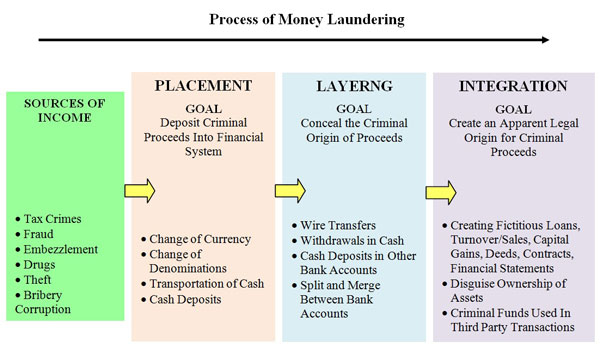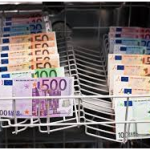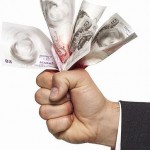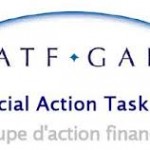Stages of money laundering

 Each day the methods used by money launderers become more sophisticated and the financial transactions more complex. With increased use of electronic communications, the speed with which money and assets can be converted and transferred has increased exponentially.
Each day the methods used by money launderers become more sophisticated and the financial transactions more complex. With increased use of electronic communications, the speed with which money and assets can be converted and transferred has increased exponentially.
There is no specific method of laundering money. Despite the variety of methods employed, the laundering process is accomplished in three basic stages which may comprise transactions by the launderers that could alert a financial institution to criminal activity.
The Money Laundering Process
Money laundering is not a single act but is in fact a process that is accomplished in three basic steps. These steps can be taken at the same time in the course of a single transaction, but they can also appear in well separable forms one by one as well. Traditionally it has been commonly accepted that the money laundering process comprises three main stages:
a) Placement
b) Layering
c) Integration
Process of Money Laundering
Placement
The process of placing, through deposits or other means, unlawful cash proceeds into traditional financial institutions. At this stage cash derived from criminal activity is infused into the financial system. The placement makes the funds more liquid since by depositing cash into a bank account can be transfer and manipulated easier. When criminals are in physical possession of cash that can directly link them to predicate criminal conduct, they are at their most vulnerable. Such criminals need to place the cash into the financial system, usually through the use of bank accounts, in order to commence the laundering process.
This is the first stage in the washing cycle. Money laundering is a “cash-intensive” business, generating vast amounts of cash from illegal activities (for example, street dealing of drugs where payment takes the form of cash in small denominations). The monies are placed into the financial system or retail economy or are smuggled out of the country. The aims of the launderer are to remove the cash from the location of acquisition so as to avoid detection from the authorities and to then transform it into other asset forms; for example: travellers cheques, postal orders, etc.
Layering
Layering is the process of separating the proceeds of criminal activity from their origin through the use of many different techniques to layer the funds. These include using multiple banks and accounts, having professionals act as intermediaries and transacting through corporations and trusts, layers of complex financial transactions, such as converting cash into traveler’s checks, money orders, wire transfers, letters of credit, stocks, bonds, or purchasing valuable assets, such as art or jewelry. All these transactions are designed to disguise the audit trail and provide anonymity.
Layering usually involves a complex system of transactions designed to hide the source and ownership of the funds. Once cash has been successfully placed into the financial system, launderers can engage in an infinite number of complex transactions and transfers designed to disguise the audit trail and thus the source of the property and provide anonymity. One of the primary objectives of the layering stage is to confuse any criminal investigation and place as much distance as possible between the source of the ill-gotten gains and their present status and appearance.
Typically, layers are created by moving monies in and out of the offshore bank accounts of bearer share shell companies through electronic funds’ transfer (EFT). Given that there are over 500,000 wire transfers – representing in excess of $1 trillion – electronically circling the globe daily, most of which is legitimate, there isn’t enough information disclosed on any single wire transfer to know how clean or dirty the money is, therefore providing an excellent way for launderers to move their dirty money. Other forms used by launderers are complex dealings with stock, commodity and futures brokers. Given the sheer volume of daily transactions, and the high degree of anonymity available, the chances of transactions being traced is insignificant.
Integration
It is the stage at which laundered funds are reintroduced into the legitimate economy, appearing to have originated from a legitimate source. Integration is the final stage of the process, whereby criminally derived property that has been placed and layered is returned (integrated) to the legitimate economic and financial system and is assimilated with all other assets in the system. Integration of the “cleaned” money into the economy is accomplished by the launderer making it appear to have been legally earned. By this stage, it is exceedingly difficult to distinguish legal and illegal wealth.
Not all money laundering transactions go through this three-stage process. The three basic stages may occur as separate and distinct phases or may occur simultaneously or, more commonly, they may overlap. Transactions designed to launder funds can for example be effected in one or two stages, depending on the money laundering technique being used. How the basic steps are used depends on the available laundering mechanisms and requirements of the criminal organisations.
Business that are ideal for laundering cash
Given the diverse channels, through which money laundering proceeds are moved, an effective approach to combating money laundering must involve all aspects of the financial system. It must cover money that has already been “placed” into the financial system and, of course must cover money derived from other forms of crimes that has never been in the form of cash. Certain businesses that have naturally occurring high levels of cash are ideal for laundering cash:
| • Banks; • Security houses; • Financial intermediaries; • Accountants; • Solicitors; • Surveyors and estate agents; • International money transmitters; • Company formation agents and management services companies; • Casinos and bookmakers; • Art, bullion and antique dealers; • Car dealers; |
• Restaurants; • Hotels; • Bars; • Nightclubs; • Dry cleaners; • Video rental companies; • Vending machines operators; • Fairgrounds and attractions; • Parking lots; • Retail outlets; • Others, dealing in high value commodities and luxury goods. |
Find more: Contributing Authors































Thank you for another fantastic post. Where
else may anybody get that kind of info in such an ideal means of writing?
I have a presentation subsequent week, and I’m at the
look for such information.
Hеllo, I eenjoy reading throᥙցh your post.
I like to writе a little comment to support you.
Thank you for this informative post.
Money laundering is such a complex topic that most people do not understand but you have explained it exhausitively.
Thank you
I do not even know the way I ended up right here, but I believed this publish used to be great.
I do not realize who you are but definitely you are going to
a well-known blogger in case you are not already. Cheers!